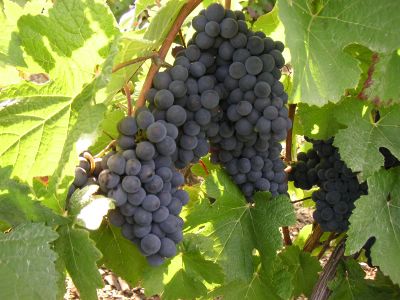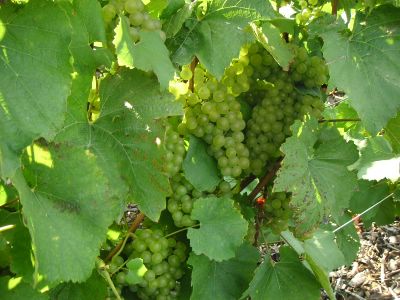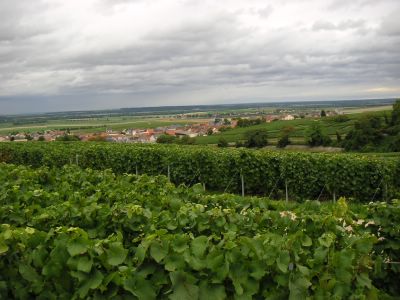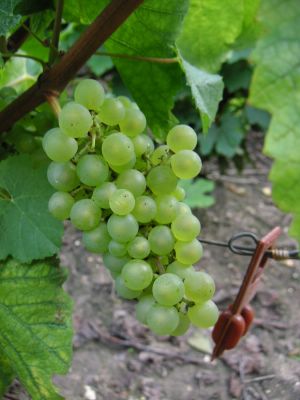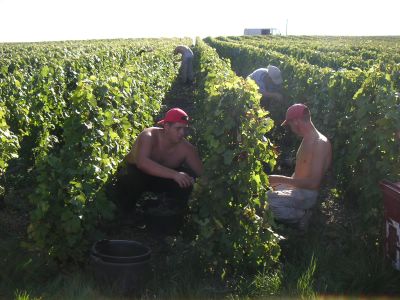 The grapes of the plot "Belles Feuilles" is picked on a very sunny day.
The grapes of the plot "Belles Feuilles" is picked on a very sunny day.The grapeharvest is over. I have followed it from the kitchen, that is from the steaming giant pots of our cook of the week, Annie. In the kitchen of the
vendangeoir I have heard one guest after the other with their "c'est de belles grappes".
Our 10 grapepickers and the rest of the team share this opinion. Very little rot in the grapes so far, and even the berries are not as big as last year, there are plenty of them, so the grapes still come out rather heavy.
Most green grapesThe grapeharvest takes seven days at our place. More days are too tiresome for everybody, is the general opinion. We will leaving plenty of the green
Chardonnay-grapes on the vines. Enough for the migrating birds to afterparty when they will be arriving well into the autumn. A little less of the
Meunier-grapes even though enough to deliver the quota of 13.000 kilos per hectare.
Our
Esca-torn vineyard now produces visibly less grapes. We can still deliver what we are supposed to, but it is obvious that within some years there may not be enough grapes to harvest, if we do not do something about the problem. That is replant the plot. A situation that we share with many other
vignerons as the
Esca-disease seems to move north with the rising temperatures.
Great weatherThe weather has been just great. The heatwave of last week thank god ended before we started picking. It is hard to pick grapes for a week. Just about the last thing you need is that you must do it in 30 degrees Celsius.
Morningmist, grey skies, light showers and temperatures that only in the middle of the afternoon pass 20 degrees Celsius are much better. The only really warm day is blessed with a wind of a strength quite unusual in Champagne. It makes it okay to work despite the heat.
"There is always something"Bad luck hit in several tempi. Gérard got a bad cold, could not move his neck and eventually also not drive to carry the grapes to the presses.
Even worse, four winepickers got so tired - two of them mainly due to solidarity, it seems - that they decided to go home the day before the last day. Some friends and family came to help so it all ended friday as planned anyway.
When asked Gérard only said: "There is always something coming up". But it was the first time, that our family experienced this kind of mass exodus. I guess it was also first time or at least not often that new pickers turned out to be
that slow. Apart from me... but I never really count as part of the team. I am just there to help out the tired ones.
Do not sit on your bumAs one of the local "big mouths" passed by on the second day, he had a clear opinion after the sight of the two girls sitting on their bum while working. This, he said, would never be accepted by my wife.
Personally I now the time where your body just do not want to be bend over the vines anymore, but only kindly accepts to move on from a position with the bum straight on the ground. The problem is that it takes a lot longer to move from one plant to the next if you sit on your bum. And time is money, is it not?
Some places would just fire slow workers straight away after seeing the lack of potential after one day's work. Not in our family, where the tradition is that pickers help each other. Just not these girls who tended to slow down when they actually got help. Which would make the others work even more. Hmm, I guess that is why some
vignerons just fire the slow ones pretty much straight away.
The harvest goes onThe
vendange finished nicely though. Of Course. As always. So far only the first villages are completely done. The first
communes began picking the grapes already on September 9th, the last ones only this weekend.
Vertus, as we belong to, is almost finished. You hardly see any cars and tractors carrying grapes anymore. The Côte des Blancs-villages Avize and Le-Mesnil-sur-Oger still worked this weekend as well as several Montagne de Reims-villages. Several
vignerons in Verzy finished today... easy to recognize as they sounded their horns and decorated their cars with vineleaves.
Officially the grapeharvest only ends well into the month of October. So it is still far to early to say anything about the vintage of 2006. Even "there is always something" I guess it will all come out nicely. As always.
På danskCopyright: The copyright for text and photos at bobler.blogspot.com belongs to Solveig Tange. You may use my articles, photos or parts of them for non-commercial use and if I am credited as the author. Feel free to link to this site but not in your own frameset please.




